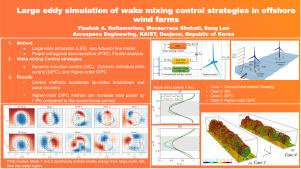海上风电场尾流混合控制策略的大涡模拟
IF 10.9
1区 工程技术
Q1 ENERGY & FUELS
引用次数: 0
摘要
尾流-涡轮机的相互作用降低了风电场的输出功率,特别是在下游涡轮机在上游机组的尾流中运行的对齐布局中。本研究评估了已建立的尾流混合控制策略,包括动态感应控制(DIC)、基线动态个体螺距控制(DIPC)和一种新的高阶DIPC方法,以增强浮式海上风力发电机的尾流恢复。采用壁面大涡模拟,结合致动器线模型,对中性分层湍流大气边界层下的双涡轮风电场进行了模拟。通过适当的正交分解、平均动能通量和傅里叶变换技术对流场进行分析,发现基于dipc的方法通过更高的能量夹带和尖涡击穿显著增强了尾流混合,特别是在低于额数的风区。高阶DIPC方法结合了两个正弦桨距信号,具有更大的能量通量和显著的尾迹偏转,可以改善下游涡轮的性能。与传统的Greedy方法相比,尾迹混合控制方法通常增加了加速尖端涡击穿的互感不稳定模式的增长率。在风力机性能方面,高阶DIPC方法的总功率比贪心情况提高了7.9%,比基线DIPC提高了2.3%,同时结构载荷和平台运动也略高。这些发现表明了尾流强迫在海上风电场中提高尾流回收率和发电量的潜力,显示了桨叶俯仰频率的主导模式及其对激励浮动平台运动的影响。本文章由计算机程序翻译,如有差异,请以英文原文为准。

Large eddy simulation of wake mixing control strategies in offshore wind farms
Wake-turbine interaction reduces power output in wind farms, especially in aligned layouts where downstream turbines operate in the wake of upstream units. This study evaluates established wake mixing control strategies, including dynamic induction control (DIC), baseline dynamic individual pitch control (DIPC), and a new higher-order DIPC method for enhancing wake recovery in floating offshore wind turbines. Wall-modeled large eddy simulation, coupled with an actuator line model, is employed to simulate a two-turbine wind farm under a neutrally stratified turbulent atmospheric boundary layer. The flow fields are analyzed using proper orthogonal decomposition, mean kinetic energy flux, and Fourier transformation techniques, which revealed that the DIPC-based methods significantly enhance wake mixing through a higher energy entrainment and tip-vortex breakdown, especially in below-rated wind region. The higher-order DIPC method, which combines two sinusoidal blade pitch signals, exhibits greater energy flux as well as a notable wake deflection that can improve downstream turbine performance. Compared to the conventional Greedy method, the wake mixing control methods generally increase the growth rates of mutual inductance instability modes that accelerate tip-vortex breakdown. In terms of wind turbine performance, the higher-order DIPC method achieves a 7.9% increase in total power relative to the Greedy case and 2.3% more than the baseline DIPC, while having slightly higher structural load and comparable platform motions. These findings demonstrate the potential of wake forcings to increase wake recovery and power yield in offshore wind farms, showing the dominant modes in the blade pitching frequency and their effect on exciting floating platform motions.
求助全文
通过发布文献求助,成功后即可免费获取论文全文。
去求助
来源期刊

Energy Conversion and Management
工程技术-力学
CiteScore
19.00
自引率
11.50%
发文量
1304
审稿时长
17 days
期刊介绍:
The journal Energy Conversion and Management provides a forum for publishing original contributions and comprehensive technical review articles of interdisciplinary and original research on all important energy topics.
The topics considered include energy generation, utilization, conversion, storage, transmission, conservation, management and sustainability. These topics typically involve various types of energy such as mechanical, thermal, nuclear, chemical, electromagnetic, magnetic and electric. These energy types cover all known energy resources, including renewable resources (e.g., solar, bio, hydro, wind, geothermal and ocean energy), fossil fuels and nuclear resources.
 求助内容:
求助内容: 应助结果提醒方式:
应助结果提醒方式:


